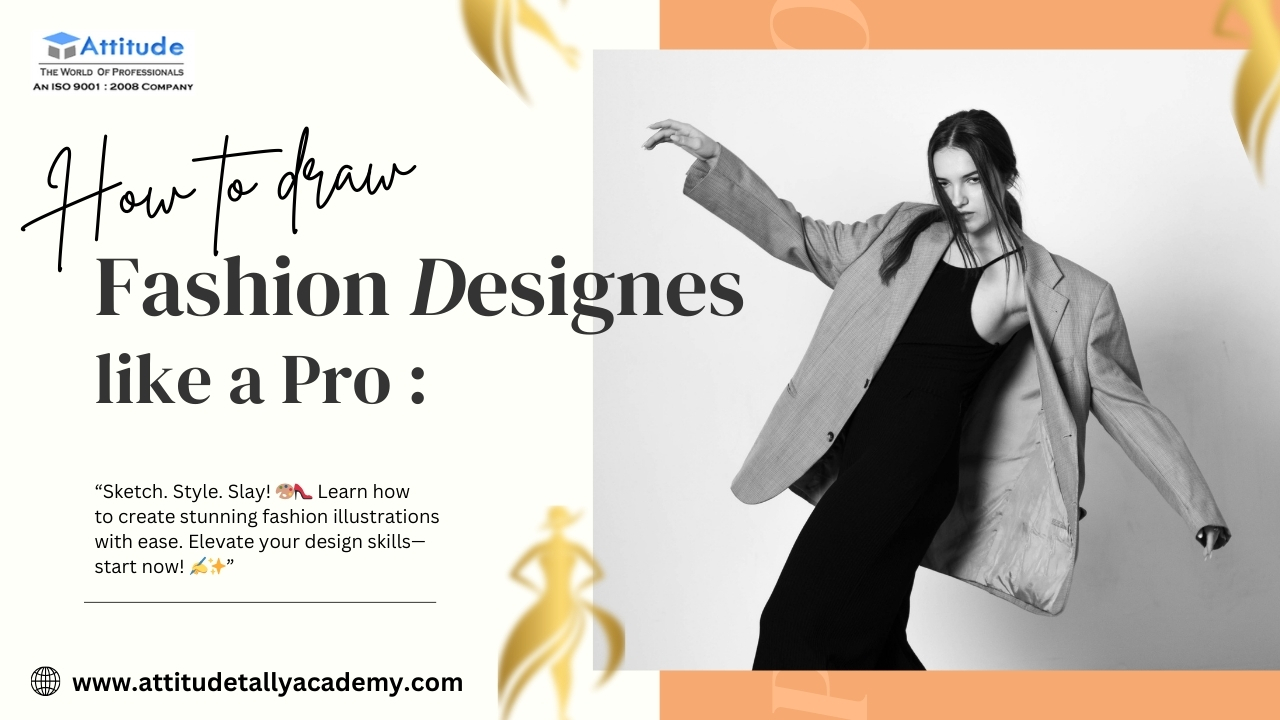Introduction
Fashion design is a perfect blend of creativity and technical skill. It’s about translating your ideas into wearable art that expresses personal style, culture, and innovation. Whether you want to create your own clothing line or learn a new hobby, drawing fashion designs is an essential skill every designer needs to master. If you’re a beginner, learning to sketch fashion designs may seem like a challenge, but with the right approach, you’ll be able to draw like a pro in no time. This tutorial will take you step-by-step through the process, and if you’re looking for more hands-on learning, enrolling in a fashion designing course in Yamuna Vihar is a great way to boost your skills.
-
Understanding Fashion Drawing Basics
Fashion drawing is the visual tool used to bring design ideas to life. It communicates everything from the silhouette, color, fabric, texture, and accessories of the garment. Fashion sketches allow designers to express their vision before creating a prototype or final piece.
As a beginner, it’s important to focus on creating croquis, the fashion figure used in sketches. A croquis is typically drawn with elongated proportions, approximately 9-10 heads tall, which helps to accentuate the flow and elegance of the clothing. This helps in demonstrating the garment more dramatically, even though the figure doesn’t necessarily reflect real human proportions.
-
Gathering the Essential Tools
Before you start drawing, make sure you have the right tools. The right materials will allow you to create precise and professional-looking designs. Here’s what you’ll need:
- Pencils: A selection of pencils ranging from H (hard) to B (soft) for outlines and shading.
- Paper: Smooth, high-quality sketching paper that allows for detailed work.
- Eraser: A soft eraser to correct mistakes without damaging your paper.
- Ruler: To create straight lines for more structure.
- Colored Pencils/Markers: Used for adding color and texture to your designs.
- Fashion Templates: These are especially helpful for beginners to practice proportions and poses of the fashion figure.
These tools are essential to get your designs to look professional and polished.
-
Drawing the Fashion Figure (Croquis)
The first step in fashion drawing is to create the croquis, which serves as your guide for drawing the rest of the design. Start by drawing a vertical line down the middle of your page to represent the center of the body. This line will be your reference for symmetry. Next, add horizontal lines across the figure to indicate the head, shoulders, waist, hips, and knees.
Once you’ve established the structure, begin to draw the shape of the arms, legs, and head. Fashion figures are usually taller and thinner than normal human proportions, so make sure your figure is elongated. The arms should be drawn with the hands gently extended, as most fashion sketches convey grace and elegance.
To assist with proper proportions, use a croquis template that will help you maintain the correct size and posture. This step provides the base for your fashion design, so take your time in getting the proportions right.
-
Sketching the Clothing
Now that the figure is ready, it’s time to sketch the clothing. Start with outlining the basic shape of the garment. Focus on the silhouette—whether it’s a flowing dress, fitted pants, or a structured jacket. This is the stage to represent the overall structure of the clothing without focusing too much on the details.
Remember to take into account how the fabric behaves. For example, a gown made of silk will have flowing, smooth lines, while a jacket made from denim will have more defined edges and structure. Keep the fabric’s nature in mind while sketching. This step is crucial, and a Dress Designing Course in Yamuna Vihar can further enhance your understanding of fabric behaviors, fit, and construction techniques.
-
Adding Details to the Garment
Once the basic shape is in place, you can add specific details that define the design. For instance, you may want to add buttons, pleats, sleeves, zippers, or a collar. These details bring your design to life and make it unique.
Details such as seams, folds, and stitching can add realism to your sketches. Consider how these elements contribute to the overall feel of the garment. The length of a sleeve, the shape of a neckline, or the placement of a pocket can make a garment stand out. At this point, you can focus on defining the design with clean, bold lines.
If you’re serious about mastering fashion design, enrolling in a Fashion Designing Training Institute in Yamuna Vihar will give you expert guidance in refining these details, from drawing techniques to fabric and construction knowledge.
-
Shading and Adding Texture
Shading is essential to give your fashion design depth. It transforms a flat sketch into a more realistic representation. Start by shading areas that would naturally be in shadow, like the sides of the body or under the arms. Use softer strokes to add subtle shading to the fabric.
Different fabrics will require different types of shading. For example, a leather jacket will have sharp, darker shadows, while a flowy dress made of chiffon or silk will have softer shadows. The use of texture in fashion sketching helps convey the material of the garment, making your design more lifelike.
Learning to shade fabrics correctly is crucial in fashion drawing. A Fashion Designing Coaching Centre in Yamuna Vihar can teach you advanced shading techniques, helping you achieve more lifelike results in your sketches.
-
Adding Color to Your Designs
Now that your sketch is shaded, it’s time to add color to bring the design to life. Use colored pencils, markers, or digital tools to color the garment. Start with a light base layer of color and build it up gradually. You can blend different shades to create depth and dimension.
Coloring brings energy to the design, and you should choose colors that match the garment’s mood. Bright, bold colors may suit a playful design, while pastel or darker shades could be better for more sophisticated looks.
Digital tools like Adobe Illustrator are also great for adding color to fashion sketches, and many Fashion Designing Institutes in Yamuna Vihar teach students to use these tools effectively.
-
Final Touches and Refining Your Sketch
Once you’ve added color, take a moment to step back and evaluate your design. Make any necessary adjustments to proportions, shading, or details. Use a darker pencil to re-outline areas that need more definition. Clean up any stray lines or smudges with an eraser. This is where you refine the design to make it look more professional.
At this point, you can also add accessories like handbags, shoes, or jewelry to complete the look. These final touches will make your design appear more polished.
-
Improve Your Skills with Professional Training
While self-practice is essential, formal training can help you advance your skills much faster. If you’re passionate about fashion design and want to improve your drawing abilities, consider joining a Fashion Designing Training Institute in Yamuna Vihar. Professional training will not only improve your technical skills but also teach you about the fashion industry, garment construction, and the latest design software like AutoCAD and Adobe Illustrator.
A Dress Designing Coaching Institute in Yamuna Vihar will provide a hands-on approach to learning and allow you to receive feedback from experienced designers. This exposure is essential to developing a well-rounded portfolio.
Conclusion
Drawing fashion designs like a pro takes time, patience, and continuous practice. By learning the basics of sketching, understanding proportions, and adding color and details, you can create beautiful, professional-looking fashion designs. As you refine your skills, consider enrolling in a Fashion Designing Course in Yamuna Vihar or a Dress Designing Course in Yamuna Vihar to gain hands-on experience, expert instruction, and exposure to industry tools and techniques.
With consistent practice and training, you can master the art of fashion sketching and bring your creative ideas to life.




